Your 34th Week
If your baby was born this
week, she’d still need some help with breathing and feeding. But it’s
reassuring to know that basically she’s in pretty good shape for
survival. However, you are unlikely to go into labor this early. Now is
your chance to start practicing the relaxation and pain-relieving
exercises that you’ve been learning at your prenatal classes. The more
familiar you are with the techniques, the more they will help you during
labor.
NOTE
Your baby is almost fully equipped for the outside world
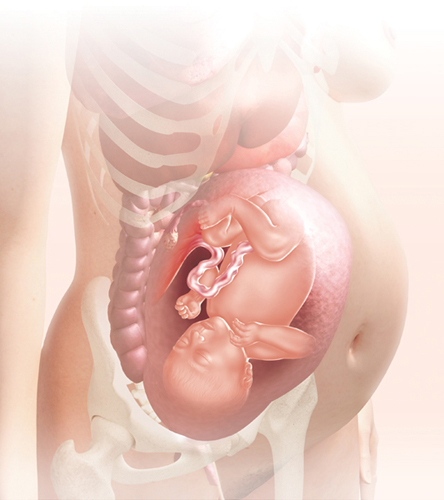
You are 33 Weeks and 1 Day 48 days to go…
Premature labor is highly likely in a twin pregnancy, so your doctor will be on alert and monitoring you closely.
Your baby today
Your baby may well be head down by this stage. The head is the
heaviest part and gravity plus the shape of your uterus favors a
head-down position. Ask your doctor at the next visit if she can
determine the position for you.
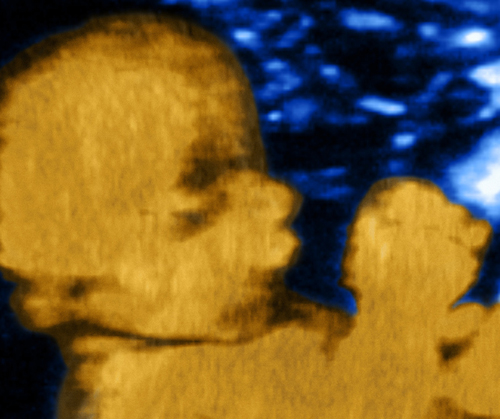
There’s still six weeks to go until the due date
for a single pregnancy, but if you’re expecting twins they may arrive
any time from now. Most singleton pregnancies are 38 to 42 weeks, but if
you’re carrying twins, 37 to 39 weeks is optimal. But more than half of
twins are born before 37 weeks. Women expecting twins are at higher
risk of high blood pressure, preeclampsia, placental insufficiency,
gestational diabetes, and premature labor. That said, many women do go
on to deliver twins naturally and many doctors will allow you to
continue to 40 weeks, after which time an induction or cesarean might be
suggested.
If the babies are in any
position other than “head down,” or the placenta is in an awkward
position, such as near the neck of the uterus, a cesarean may be
recommended. Some doctors prefer to deliver twins by cesarean because
the second twin may run into difficulties during the delivery,
particularly if she is not head down. Premature babies are more at risk
of complications than those who go to full-term. A cesarean delivery
ensures the babies are delivered quickly without having to go through
hours of potentially stressful labor.
Sometimes, one twin is
born vaginally and the other by cesarean. This often happens if the
lower twin is in the “head down” position and the higher twin isn’t.
If you know your twin pregnancy is going to be induced or you’ve arranged a cesarean delivery, you have the advantage of being able to fully prepare for your babies’ arrival.
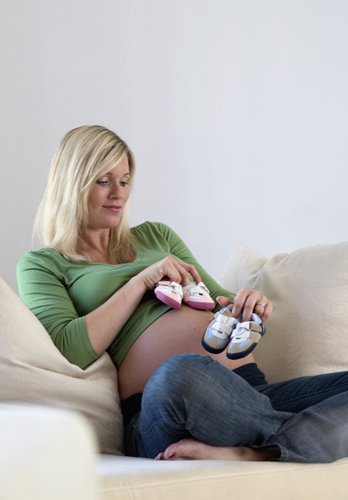
The average birth weight of twins is 5 lb 5 oz (2.6 kg).
This is compared to 7 lb 8 oz
(3.5 kg) for singleton babies. It’s not unusual for there to be a
difference in birth weight between the babies. In fact, one twin may
weight 2 to 3 lb more than the other.
… Doctor
| Q: |
I’m having my twins in a couple of weeks. Can they sleep in the same crib?
|
| A: |
Having shared the same tight space in the uterus for many
months, it seems natural to allow twin newborns to sleep together and,
in fact, research indicates that it may have some benefits. Not only has
it been found to be safe for twins of roughly the same size to sleep
together until three months of age, but one study found that putting
newborn twins in the same crib helped regulate their body temperature
and their sleep cycles.
They can be placed
side by side, or head to head. To be safe, don’t overdress them or use
blankets, bumpers, or pillows. Make sure the mattress is firm with a
fitted sheet over it. Like singletons, twins should be put to sleep in
the safe sleeping position, on their backs .
A double crib,
which will last until your twins are old enough to move to a bed, but
many experts believe twins should be given their own sleeping space from
three months, so they can be given individual attention and the
opportunity to develop their own sleep patterns.
|
You are 33 Weeks and 2 Days 47 days to go…
With well-developed hearing, your baby may not be getting as much peace and quiet as she would like in the uterus.
Your baby today
Shadows give the impression of hair on the eyebrows and
eyelashes on this 3D image. Because this baby was lying head down, the
view of the top part of the head is lost in the shadows caused by the
mother’s pelvis.
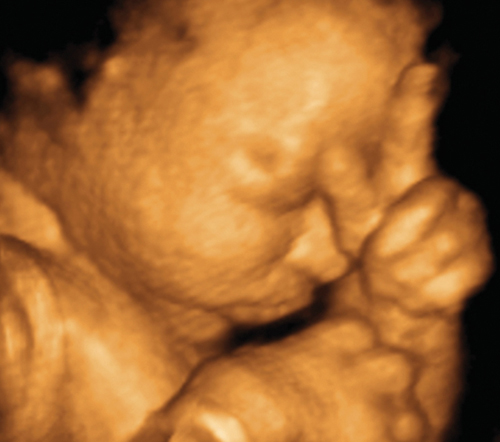
Although some quieter high-pitched sounds
don’t penetrate the uterus, it is not quite as peaceful for your baby
as you might think. There will be a constant background noise produced
by your heart beating, your breathing, and your stomach rumbling. While
the uterus and amniotic fluid will prevent many quieter sounds from
reaching your baby, voices do penetrate quite easily. Your baby has
already learned to adapt to repetitive sounds but is now acquiring a
memory for familiar noises. The most familiar sound is, of course, your
voice. Your baby will startle and turn toward loud or unfamiliar sounds
and these will also cause her heart rate to increase.
… Your baby
Lie and presentation
Your baby’s lie and presentation will be assessed by your doctor at every prenatal appointment.
Your baby’s “lie”
means which way round she is lying, vertically or horizontally—a
horizontal lie is known as transverse. The “presentation” refers to
which part of the baby is closest to the pelvis, and would come out
first.
The most common presentation is head down, bottom up, called the cephalic presentation. Breech presentation (see image)
is when the baby is bottom or feet down with the head upward. A
footling breech means that the baby is head up, with one leg and foot
extended downward while the other is tucked in. In an anterior
presentation (see below), your baby’s head is down and faces your back.
In a posterior presentation, your baby’s head faces your belly, which
can prolong labor and may increase the chances of an assisted delivery.
Cephalic presentation
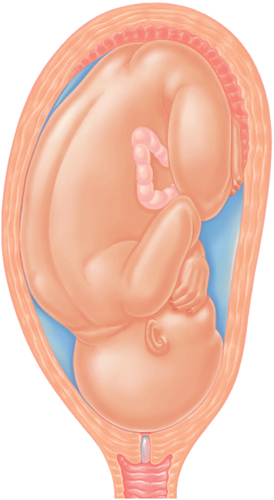
Breech presentation
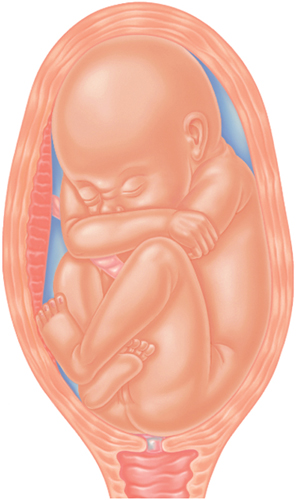
… Doctor
| Q: |
What is perineal massage and how do I do it?
|
| A: |
Spending just five minutes a day massaging your perineum (the
area between the vagina and anus) with oil could reduce your risk of
tearing or having an episiotomy
during the birth. It also means you’re less likely to experience pain
in that sensitive spot after the birth—even after having an episiotomy.
Here’s how to do it:Wash
your hands. Apply a mild lubricant, like K-Y jelly, to your thumbs,
then slide them an inch inside the vagina. Gently stretch the vagina
until you feel a slight stinging sensation. When
you feel that sensation, hold the pressure steady until you no longer
feel the stinging. Then gently massage the lower half of the vagina with
your thumbs. With your thumbs hooked in the vagina, pull forward to
stretch the skin. Not
sure you’re doing the first part properly? Insert your fingers into the
corners of your mouth and pull your mouth open to the sides for a
similar “burning” sensation.
|